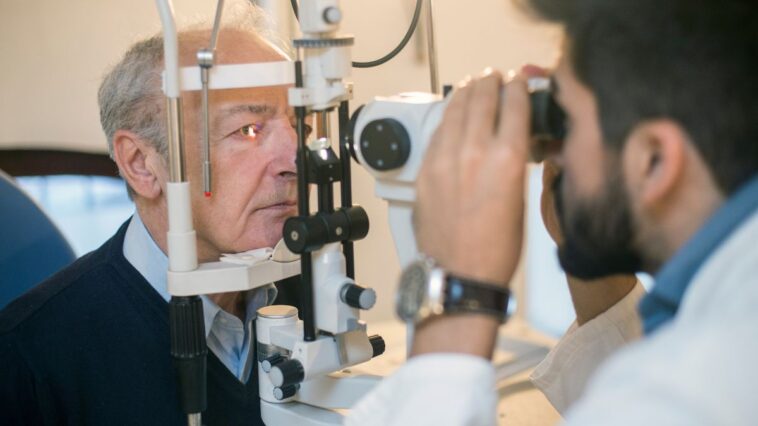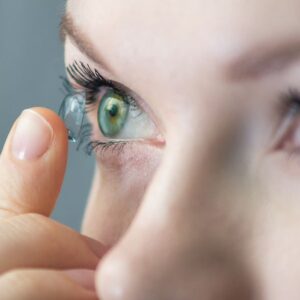What is Diabetic Retinopathy?
Diabetic retinopathy is an eye condition that affects people with diabetes. It occurs when high blood sugar levels cause damage to the retina, the light-sensitive layer at the back of the eye. It occurs when high blood sugar levels damage the blood vessels in the retina. This can cause the blood vessels to leak blood and other fluids, leading to retina swelling and scarring.
There are two types of diabetic retinopathy: non-proliferative diabetic retinopathy (NPDR) and proliferative diabetic retinopathy (PDR).
Non-proliferative diabetic retinopathy (NPDR) is the early stage of diabetic retinopathy. In this stage, the blood vessels in the retina become blocked or leaky. This can cause the retina to swell, known as diabetic macular edema. This stage can cause mild vision loss or no symptoms at all.
Proliferative diabetic retinopathy (PDR) is the advanced stage of diabetic retinopathy. In this stage, new blood vessels grow on the retina’s surface or in the vitreous. These new blood vessels are fragile and can bleed easily, which can cause vision loss or blindness.
Symptoms of diabetic retinopathy may include blurred vision, floaters, or difficulty seeing at night. However, in the early stage of diabetic retinopathy, there may be no symptoms. This is why people with diabetes need regular eye exams to detect potential problems early.
People with diabetes should attend regular eye exams to detect potential problems and begin treatment before developing more severe symptoms. Early detection is critical to slow or halt the progression of diabetes-related vision problems and preserve one’s sight.
How Diabetes Can Affect the Eyes
Diabetes is a severe medical condition that affects millions of people around the world. It occurs when the body either doesn’t produce enough insulin or cannot properly use the insulin it produces. Insulin is a vital hormone that helps to keep blood sugar levels regulated. While diabetes can have a variety of adverse effects on the body, it can also have a significant impact on the eyes.
One of the most common eye problems associated with diabetes is diabetic retinopathy. This occurs when high blood sugar levels damage the blood vessels in the retina. As a result, the blood vessels may leak blood and other fluids, which can cause the retina to swell and scar. This can lead to vision loss or blindness if left untreated.
Diabetes can cause various eye problems, including cataracts. They are more common in people with diabetes and can occur at a younger age than in people without diabetes. A cataract is an area of cloudiness on the lens in the eye which can lead to blurry or distorted vision.
Glaucoma is another eye condition that is more common in people with diabetes. Glaucoma is when the pressure inside the eye increases and can damage the optic nerve. This can lead to vision loss or blindness if left untreated.
An eye exam is essential to diabetes care to protect your vision. Regular exams can help you detect changes in your eyes related to diabetes and take the necessary steps to address any issues.
These exams can help detect eye problems early, preventing or slowing down the disease’s progression. You can also help protect your vision by controlling your blood sugar levels, eating a healthy diet, and not smoking.
Diabetes can significantly impact the eyes and lead to several eye problems, including diabetic retinopathy, cataracts, and glaucoma.
If you are concerned about diabetes and its potential effect on your eyesight, consult your doctor for advice. They will be able to guide how best to manage the condition and reduce its impact on your vision. Regular eye exams and a healthy lifestyle can help protect your vision if you have diabetes.
Diabetic Eye Exam: Why It’s Important
Regular eye exams are essential for people with diabetes to ensure that any potential eye problems are detected and treated early. People with diabetes are at a higher risk of developing eye problems, such as diabetic retinopathy, cataracts, and glaucoma, which can cause vision loss or blindness if left untreated.
During an eye exam, an eye doctor will perform a dilated eye exam, which allows them to examine the retina, blood vessels, and other parts of the eye. This can help detect any signs of diabetic retinopathy, cataracts, or glaucoma. The eye doctor may also check for other eye problems that are more common in people with diabetes, such as dry eyes or diabetic macular edema.
If an eye problem is detected during an exam, your eye doctor will work with you and your primary care physician to develop a treatment plan. This may include medication, laser therapy, or surgery.
It is recommended that people with diabetes have an eye exam at least once a year or more frequently if they have been diagnosed with diabetic retinopathy or other eye problems.
In addition to regular eye exams, controlling blood sugar levels, eating a healthy diet, and not smoking can also help protect your vision if you have diabetes.
In conclusion, regular diabetic eye exams are essential to ensure that any potential eye problems are detected and treated early.
Early detection and treatment can help prevent or slow down the progression of the disease and protect your vision. If you have diabetes, schedule regular eye exams and work with your doctor to manage your condition and protect your vision.
Who are Most at Risk for Developing Retinopathy?
Diabetes is a condition that raises the risk of developing retinopathy. This occurs when high blood sugar levels damage the delicate blood vessels in the retina located at the back of the eye. With prolonged diabetes, the risk of retinopathy increases.
However, certain groups of people with diabetes are at an even higher risk of developing retinopathy:
- People with type 1 diabetes who have had the disease for more than 10 years.
- People with type 2 diabetes have had the disease for over 20 years.
- People who have poor blood sugar control.
- People who have high blood pressure or high cholesterol.
- People who are overweight or obese.
- Women who have had gestational diabetes during pregnancy.
- People with a family history of diabetic retinopathy.
It is important to note that people with diabetes should have regular eye exams to detect any potential problems early, even if they do not have any symptoms. Early detection and treatment can help prevent or slow down the progression of the disease and protect your vision.
In addition to regular eye exams, controlling blood sugar levels, eating a healthy diet, and not smoking can also help protect your vision if you have diabetes. It’s also essential to keep blood pressure, cholesterol, and weight in check and follow the treatment plan recommended by your doctor.
How Often Should a Diabetic Have an Eye Exam?
If you have diabetes, taking care of your eyes is essential. Diabetes can cause several eye problems, including diabetic retinopathy, which can lead to vision loss.
People with diabetes should have a comprehensive dilated eye exam at least annually. This is recommended to aid in the early detection of any changes or complications associated with diabetes.
During this exam, an eye doctor will dilate your pupils with drops, which allows them to see the back of your eye more clearly. This is important because diabetic retinopathy can cause changes in the retina’s blood vessels.
During a comprehensive eye exam, the eye doctor will look for signs of diabetic retinopathy, such as leakage from blood vessels, swelling of the retina, and abnormal growth of new blood vessels. They may also check for other eye problems caused by diabetes, such as cataracts and glaucoma.
If you have had diabetes for more than five years or have other risk factors for diabetic retinopathy, such as high blood pressure, you may need to have eye exams more often. The eye doctor will determine the frequency of eye exams based on the individual’s condition and risk factors.
Regular eye examinations are an important preventative measure for diabetes-related vision loss, as diabetic retinopathy is often asymptomatic in its early stages. Early diagnosis and treatment of diabetic retinopathy can help to reduce the risk of vision impairment.
People with diabetes should have a comprehensive dilated eye exam at least once a year, especially if they have had diabetes for more than five years or have other risk factors for diabetic retinopathy. Early detection and treatment can help prevent vision loss. If the eye doctor suggests more frequent eye exams based on the individual’s condition, it’s essential to follow their recommendations.
What Treatment Options are Available for Retinopathy?
Treatment options for retinopathy vary depending on the stage and severity of the condition. The main goal of treatment is to slow or halt the progression of the disease and prevent vision loss. Some common treatment options include:
- Laser therapy: This treatment uses a laser to destroy or shrink abnormal blood vessels in the retina. It is typically used for the early stages of diabetic retinopathy and diabetic macular edema.
- Intravitreal injection: This treatment involves injecting medication directly into the eye to reduce swelling and improve blood flow to the retina. It is typically used for diabetic macular edema.
- Vitrectomy: This surgical procedure involves removing the vitreous gel from the eye and replacing it with a sterile solution. It is typically used for severe cases of diabetic retinopathy that do not respond to other treatments.
- Anti-VEGF therapy: Anti-VEGF therapy is a type of intravitreal injection that blocks the action of a specific protein called VEGF, which causes the abnormal growth of blood vessels in the retina. This therapy is used to treat diabetic macular edema and other forms of retinopathy.
Early detection and treatment of retinopathy are crucial for preventing vision loss, so regular eye exams are essential for people with diabetes. Your eye doctor will recommend a treatment plan based on the stage and severity of your retinopathy.






